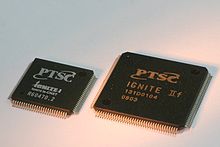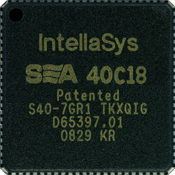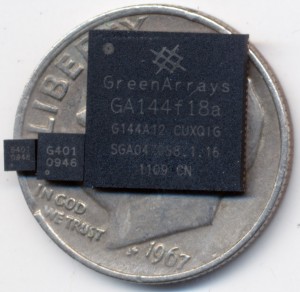Chuck Moore: Part 2: From Space to GreenArrays
Part 2 of my abbreviated biography of Chuck H. Moore’s processor designs. Part 1 covered the early days of Novix, and the RTX2000.

Patriot Scientific IGNiTE – Based on the Sh-Boom
Moore was not content to just create one processor design, or one company. In the 1980’s he also ran Computer Cowboys, a consulting/design company. In 1985 he designed the Sh-boom processor with Russell H. Fish III. This was a 32-bit stack processor, though with 16 general purpose registers, that was again designed with Forth in mind. It was capable of running much faster then the rest of the system so Moore designed a way to run the processor faster then the rest of the board, and still keep things in sync, innovative at them time, and now standard practice. The Sh-Boom was not a particularly wide success and was later licensed by Patriot Scientific through a company called Nanotronics, which Fish had transferred his rights to the Sh-Boom to in 1991. Patriot rebranded and reworked the Sh-Boom as the PSC1000 and targeted it to the Java market. Java byte code could be translated to run in similar fashion as Forth on the PSC1000 and at 100MHz, it was quick. In the early 2000’s Patriot again rebranded the ShBoom and called the design IGNITE. Patriot no longer makes or sells processors, concentrating only on Intellectual Property (Patent licensing).
After designing the Sh-Boom, and the Novix series, Moore developed yet another processor in 1990 called the MuP21. This was the beginning of a what would be a common thread in Moore’s designs. MISC (Minimal Instruction Set Computer), which is essentially an even simpler RISC design, multiprocessor/multicore, and efficiency have become the hallmarks of his designs. The MuP21 was a 21 bit processor with only 24 instructions. At 20MHz performance was 80 MIPS as it could fetch four 5-bit instructions in a 20 bit word. It was manufactured in a 40 pin DIP on a 1.2 micron process with 7000 transistors.
 In 1993 Moore designed the F21, again a 21 bit CPU based on the MuP21, designed to run Forth, and including 27 instructions. It was fab’d by Mosis on a 0.8u process. The F21 microprocessor contains a Stack Machine CPU (with a pair of stacks like the NC4000), a video i/o coprocessor, an analog i/o coprocessor, a serial network i/o coprocessor, an parallel port, a real time clock, some on chip ROM and an external memory interface. Performance was 500 MIPS (this was an asynchronous design, so ‘clock speed’ is a bit of a misnomer) and transistor count had risen to about 15,000. The F21 was made up through 1998, however the design continued to evolve. A version of the F21 was developed called the i21, originally for Chuck Moore’s iTV Corporation, which was one of the very first set top Internet appliance companies. It integrated additional featured such as infrared remote interface, modem DMA interface and a keyboard DMA interface. The F21 scaled well, and was tiny, remember, only 15,000 transistors, which at 0.18u takes up a VERY small die, and allowed performance to hit 2400MIPS @ 1.8V. One could put a very large amount of these on a single die…..
In 1993 Moore designed the F21, again a 21 bit CPU based on the MuP21, designed to run Forth, and including 27 instructions. It was fab’d by Mosis on a 0.8u process. The F21 microprocessor contains a Stack Machine CPU (with a pair of stacks like the NC4000), a video i/o coprocessor, an analog i/o coprocessor, a serial network i/o coprocessor, an parallel port, a real time clock, some on chip ROM and an external memory interface. Performance was 500 MIPS (this was an asynchronous design, so ‘clock speed’ is a bit of a misnomer) and transistor count had risen to about 15,000. The F21 was made up through 1998, however the design continued to evolve. A version of the F21 was developed called the i21, originally for Chuck Moore’s iTV Corporation, which was one of the very first set top Internet appliance companies. It integrated additional featured such as infrared remote interface, modem DMA interface and a keyboard DMA interface. The F21 scaled well, and was tiny, remember, only 15,000 transistors, which at 0.18u takes up a VERY small die, and allowed performance to hit 2400MIPS @ 1.8V. One could put a very large amount of these on a single die…..

IntellaSys SEAforth 40C18 – 40 C18 cores
In the late 1990s Chuck designed the C18 processor core, which was designed to run a version of Forth called colorForth (also invented by Moore). It was an 18 bit design, again with 2 stacks. It had 32 basic instructions. It is again an asynchronous design so does not have a clock rate. The C18 core was used by IntellaSys in their multicore processor (using 24 or 40 or the C18 cores). These were available for only a short time as unfortunately when Moore left the company in 2008 they became a NPE (Non-Practicing Entity, essentially a patent troll).
In 2009 Moore founded GreenArrays Inc, really the culmination of 25 years of processor design. Moore realized that what was needed for truly ubiquitous computing, was small, versatile, inexpensive, and scalable processing. At GreenArrays he developed the F18A CPU core. It is very similar to the C18, 18-bit dual stack, Forth processor. At 0.18u 8 of these cores fit on a single square mm of die space. Die size is 241um x 523um, yes that’s a die size measured in microns. Depending on chip configurations, this yields between 100,000 and 200,000 computers per 8 inch wafer. It is important to note that these are regarded as computers, each F18 core is independent of each other, and being clockless, is purely data driven. Instructions execute as fast as 1.4ns (roughly 700MHz if one compares it to a clocked design).
GreenArrays makes 2 chips, the GA4 which includes 4 F18 cores on either a 3mmx3mm or 2mmx2mm chip, and the GA144 which has 128 complete F18 computers on a single package. This is the technology that will eventually drive the future of computer, fast, inexpensive, and so small as to be able to be woven into the threads of clothing, or anything else one desires. You can purchase these 144 core processors for $20, direct from GreenArrays.
Perhaps its fitting that the GA144 made in 2011 rests on a 1967 dime that Chuck Moore would have spent on a soda, back at the beginning of his career in the late 1960’s. Chuck Moore certainly does not have the billions of $$ or even the fame that Gordon Moore of Intel fame does. but one Moore is still doing what he loves, designing processors, trying to change the world of computing, and that Moore, is Chuck, a name that should not be allowed to be forgotten.



March 11th, 2013 at 10:55 pm
Isn’t neat that one of the greatest advocates of minimalism in computing uses the name “Chuck Moore!”
I think some of his moving to other companies & chip designs were due to technical &/or disputes. Certainly in the case of GreenArrays & the F-18 computer. A great example of how the technology we get to use is certainly not only determined by technical merit & demerits!
Now “GreenArrays, Inc. is pleased to announce that litigation between it and Technology Properties Limited LLC (TPL) has been settled by agreements concluded on 23 January, 2013 between Charles H. Moore, TPL, Patriot Scientific Corporation, Phoenix Digital Solutions LLC (PDS) and GreenArrays”. These disputes were over the Moore Microprocessor Portfolio of patents licensed to many huge companies & yet media & WWW coverage seemed mostly confined to posting TPL’s questionable press statements without questioning & discussion of the potential effects for Patriot Scientific’s shareholders. I hope that eventually all secrets of the past will be unsecreted so we can learn from them.
March 12th, 2013 at 12:09 am
In talking to Greg (of GreenArrays) about all things Chuck, it became fairly apparently that Chuck was very much a chip designer and engineer first, and business man second. Took people at their word, and didn’t expect people to try to take advantage of that. Sadly they often did, so Chuck went on creating companies and new chip designs.
March 12th, 2013 at 7:01 am
I wonder whether Chuck’s worst enemy has been Dan Leckrone, Chuck Moore or the correctly self-described romantic Ayn Rand. (see URL above).
(I’ve dipped into Ayn’s essays, not read any of her fiction but Chuck’s comments often remind me of Howard Roarke as portrayed by Gary Cooper & his recent life seems like a sensational epic novel, including the forbidden romance in London at Chuck’s expense, except in Rand’s novels a villain would advocate altruism &/or community. Dan Lechrone does however claim that advocated changes to patent law would benefit a few large corporations which has an appropriately populist ring to it.)
Anyway, while I know Chuck is a lot smarter than me I wonder if he may have been too influenced by Ayn’s romantic fantasies to trust business people & to believe that if you act like Ayn’s heroes, you will eventually triumph.
I hope he has, but I resent the amount of Chuck’s time wasted in the consequences of this debacle, including twice? moving to cheaper accommodation. (Although Chuck Moore likes to chuck more it should have been as suited him).
April 26th, 2014 at 8:39 am
I’ve met Chuck in person at the 1988 Australian Forth Symposium, though he would probably not remember me, like the other great men I have met (honourable mention to Elisabeth that I met there briefly too). I had a meeting with him and he revealed his potential plan to develop a 20 bit processor (eventually the mup21), while I was enthusiastic about the shboom 32 bit). It was also where we lost one of the potentially biggest assets to us, Maestro Modems, who had built a very good Novix processor based pc card board and where very keen on his processors. I had been in regular contact with Dan and Chris at Maestro for years. If we had all joined together we could have made some amazing product. Australia was a different client back then, maybe we could have avoided some sharks. I say that Chuck has some real insights into how to improve things.
I see what Chuck is trying to achieve and the need for a low end CPU like the F18, even a f16. For my designs a high continuous workflow is needed. I look forwards to a very high speed 32 bit version designed to optimise end processing work flow per energy consumption versus instead energy consumption per instruction used for lower power consumption eventually. The processor would be optimised to give the highest task performance per energy unit on continuous high work loads. Two things to note, is that speed is partly related to distance favoring smaller chips, and newer processing circuit technology (chip process technologies etc) can be more suitable to smaller designs at first, giving even just an experimental lead of years. I envision a chip made up of individual atoms today, and a way to transfer the mask. On today’s chip processes a high speed 32 bit design would be a formable processor in array connected to on die memory, capable of displacing much of present processing, and desirable. A low energy 32 bit design (and x18 bit design) could also work in conjunction with it.
The industry needs to pull itself up again, and start looking at new initiatives, monolithic GPU cores only enhance processing to a limited degree. Enhancing a design like this is one way of enhancing performance.
Thanks.
Wayne.
June 6th, 2015 at 6:27 am
[…] Chuck Moore: Part 2: From Space to GreenArrays […]